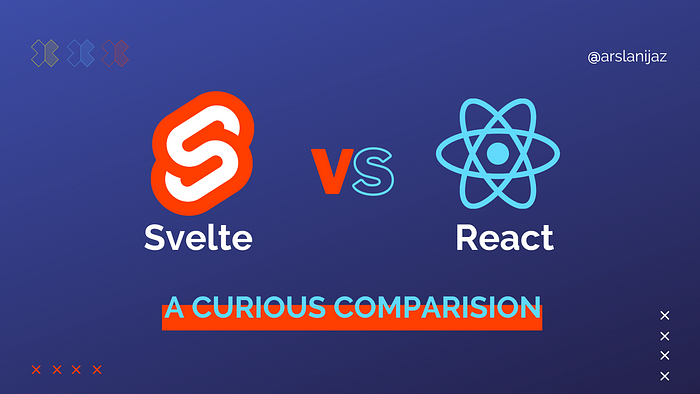 It’s no secret that web development is constantly evolving. With new frameworks and libraries coming out all the time, it can take time to keep track of them all.
But, one framework stands out among the rest: Svelte. Since its release in 2016, Svelte has been gaining traction with developers due to its superior performance capabilities and ease of use. What makes Svelte unique compared to other front-end frameworks such as React or Vue? And which should you choose for your next project in 2023?
Knowing which framework to learn can take time as the web development industry evolves. Two of the most popular choices are React and Svelte, both of which have pros and cons. But which one should you choose? This post will answer that question once and for all.
It’s no secret that web development is constantly evolving. With new frameworks and libraries coming out all the time, it can take time to keep track of them all.
But, one framework stands out among the rest: Svelte. Since its release in 2016, Svelte has been gaining traction with developers due to its superior performance capabilities and ease of use. What makes Svelte unique compared to other front-end frameworks such as React or Vue? And which should you choose for your next project in 2023?
Knowing which framework to learn can take time as the web development industry evolves. Two of the most popular choices are React and Svelte, both of which have pros and cons. But which one should you choose? This post will answer that question once and for all.
What is React?
React is a progressive JavaScript library that allows developers to create efficient user interfaces that are fast, dynamic, and scalable. It provides features such as Virtual DOM (Document Object Model) and component-based architecture so that developers can quickly implement complex UI elements into their projects. React also supports server-side rendering for improved performance on mobile devices. With its robust community support, well-documented API, and numerous libraries available for use, it’s no wonder why React remains one of the top choices for front-end development in 2023.
What is Svelte?
Svelte is a popular open-source JavaScript framework that has recently gained tremendous traction. It focuses on building user interfaces (UIs) and single-page applications (SPAs), and it has become quite the buzzword among web developers. Its distinguishing feature is its speed, as it compiles code to small chunks of efficient JavaScript that run fast in the browser. Svelte offers an easy way for developers to create interactive UIs without writing complex code, making it an excellent choice for those who want to get their projects up and running quickly. The competition between Svelte and React has been heating up since 2021 when Svelte was released as version 3.0.
4 Differences between React and Svelte
4. Smaller build bundle size
The deployed bundle size of an identical application built using React is 41.2 kB, while that same application built with Svelte is 2.1 kB — almost a 20x difference! This means developers looking to create lightweight applications should look no further than Svelte, as this framework offers excellent performance benefits for users and developers alike. Moreover, it allows for efficient loading times and faster rendering speeds which can make all the difference when building applications for smartphones or tablets.
3. Simple syntax
While React is a component-based framework that allows developers to craft complex user interfaces with declarative components, Svelte takes a more behind-the-scenes magic approach. With Svelte, developers can write meager boilerplate or syntax sugar to accomplish elaborate bindings. This can make it easier for new developers to quickly learn the technology and get up and running faster than ever before. Furthermore, Svelte has been optimized for performance from the start; its main focus is ensuring codebases remain light and fast after being compiled into JavaScript files optimized for loading times in browsers.
2. Svelte complies with HTML, CSS, and JavaScript
The critical difference between Svelte and React is that Svelte compiles the code you write into basic HTML, CSS, and JavaScript, while React needs to be bundled with your code. With Svelte, developers can quickly create lightweight applications without worrying about dealing with complex build processes. Furthermore, since the code is compiled ahead of time (AOT), it allows for faster loading times and improved performance compared to React.
1. React has React Native
React Native is one of the most highly supported cross-platform frameworks available today. It allows developers to use React to create iOS and Android applications with a single codebase. With its well-documented API, React Native makes it easier for users to build complex mobile applications. The framework has recently gained immense popularity among developers due to its flexibility, scalability, and simplicity. Since its launch in 2015, React Native has grown as an open-source platform, allowing developers to create powerful user experiences across all platforms while providing native performance on iOS and Android devices. This makes it perfect for building apps that run on multiple platforms without compromising performance or speed. Furthermore, because it’s based on JavaScript, React Native allows developers to easily reuse existing code from web projects when developing their mobile apps.
The Definitive Guide to Choosing Between
Performance: Svelte vs. React
Both provide developers with the tools they need to create incredible user experiences, but how do they compare in terms of performance? To answer this question, let’s take a closer look at Svelte vs. React in terms of performance. Regarding speed and efficiency, Svelte is often regarded as superior to React. It compiles your code into small bundles with minimal overhead meaning your pages will load quickly and smoothly for users. Additionally, as all code is compiled upfront, there’s no need for virtual DOM operations, which makes it particularly well-suited for high-performance applications such as gaming or streaming services.
Ease of Learning: Svelte vs. React
Svelte is often considered easier to learn than React due to its relative simplicity. It’s also one of the newer frameworks on the market, so it has fewer advanced features that require more in-depth knowledge. Furthermore, its coding style mimics plain JavaScript, meaning novice developers will have a lower learning curve when transitioning from HTML and CSS into JS-based development.
Tooling & Resources: Svelte vs. React
Svelte offers an easy-to-use library that makes it simple to work with reactivity. It also performs excellently, compiling components to plain JavaScript during build time. With a svelte loader, developers can quickly integrate their code into existing projects without significant headaches. Plus, its small size makes it an excellent choice for mobile applications. React offers more options than ever before — such as create-react-app and react native — making it a popular choice among developers.
Community: Svelte vs. React
Svelte stands out from other frameworks with its minimalistic approach and focus on performance enhancement. Designed with simplicity, this framework requires minimal setup and offers fast page load times without using additional tools or libraries. On the other hand, React has more comprehensive features that make it easier for developers to create complex applications quickly without compromising on quality or performance. Moreover, its component-based architecture allows for code reusability and scalability of projects.
Popularity & Job Demand: Svelte vs. React
Svelte is a relatively new framework that has been gaining traction since its release in 2018. Its focus on performance optimization makes it an attractive choice for developers who want to create fast-loading applications with minimal code. React, on the other hand, has been around since 2013 and is still widely used due to its robust library of components. It also offers more flexibility than Svelte in customizing your project’s architecture. Svelte and React have high levels of popularity within the developer community and have seen significant job demand growth over the past few years.
Conclusion
React and Svelte are viable options for developers who want to learn a JavaScript library or framework in 2023. React is a long-standing, well-known choice that will still be popular in the years ahead. Meanwhile, Svelte has emerged as an exciting new tool that offers many of the same benefits as React but with faster performance. Ultimately, the best choice for developers depends on their project needs and preferences.

